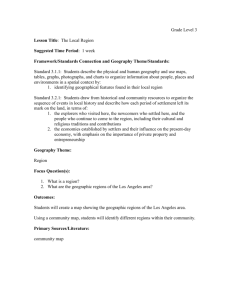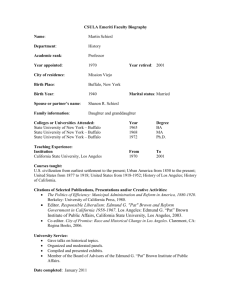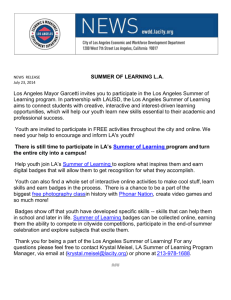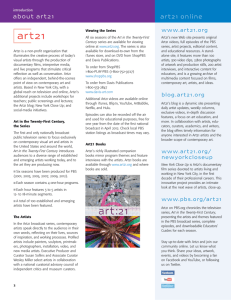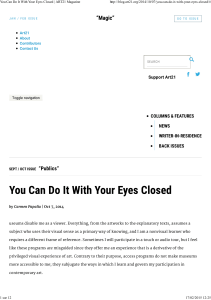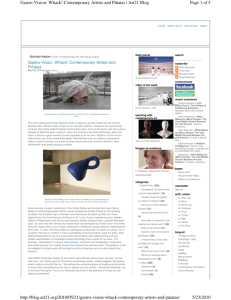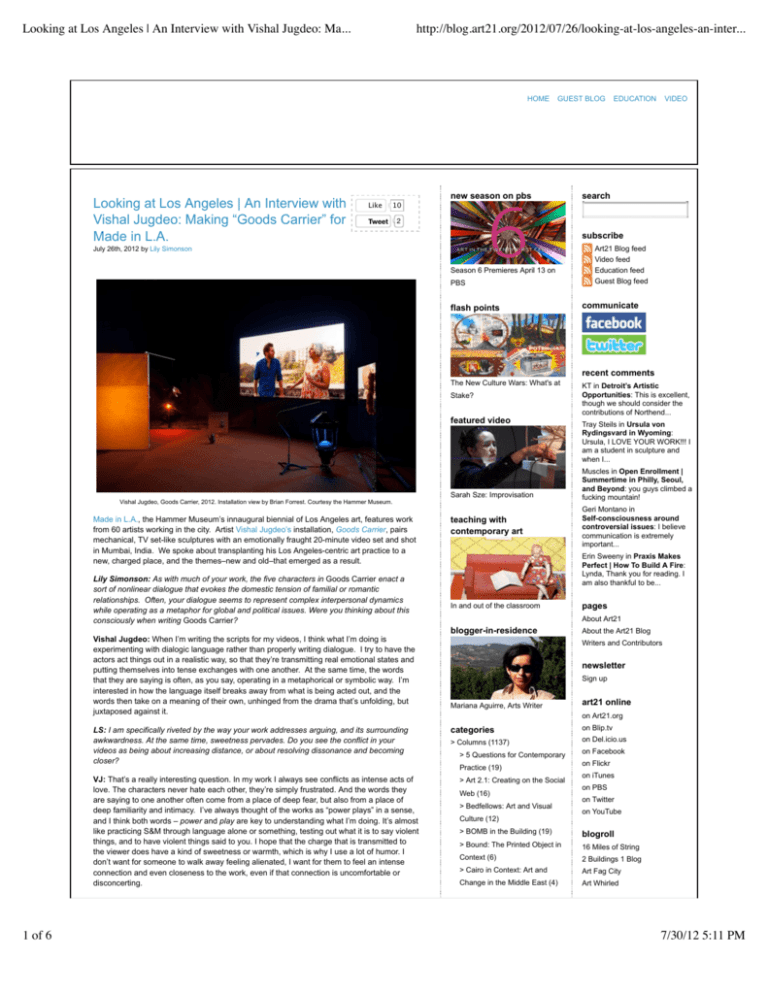
Looking at Los Angeles | An Interview with Vishal Jugdeo: Ma...
http://blog.art21.org/2012/07/26/looking-at-los-angeles-an-inter...
HOME
Looking at Los Angeles | An Interview with
Vishal Jugdeo: Making “Goods Carrier” for
Made in L.A.
GUEST BLOG
new season on pbs
Like
EDUCATION
VIDEO
search
10
Tweet
2
subscribe
July 26th, 2012 by Lily Simonson
Season 6 Premieres April 13 on
PBS
flash points
Art21 Blog feed
Video feed
Education feed
Guest Blog feed
communicate
recent comments
The New Culture Wars: What's at
Stake?
featured video
Vishal Jugdeo, Goods Carrier, 2012. Installation view by Brian Forrest. Courtesy the Hammer Museum.
Made in L.A., the Hammer Museum’s innaugural biennial of Los Angeles art, features work
from 60 artists working in the city. Artist Vishal Jugdeo’s installation, Goods Carrier, pairs
mechanical, TV set-like sculptures with an emotionally fraught 20-minute video set and shot
in Mumbai, India. We spoke about transplanting his Los Angeles-centric art practice to a
new, charged place, and the themes–new and old–that emerged as a result.
Lily Simonson: As with much of your work, the five characters in Goods Carrier enact a
sort of nonlinear dialogue that evokes the domestic tension of familial or romantic
relationships. Often, your dialogue seems to represent complex interpersonal dynamics
while operating as a metaphor for global and political issues. Were you thinking about this
consciously when writing Goods Carrier?
Vishal Jugdeo: When I’m writing the scripts for my videos, I think what I’m doing is
experimenting with dialogic language rather than properly writing dialogue. I try to have the
actors act things out in a realistic way, so that they’re transmitting real emotional states and
putting themselves into tense exchanges with one another. At the same time, the words
that they are saying is often, as you say, operating in a metaphorical or symbolic way. I’m
interested in how the language itself breaks away from what is being acted out, and the
words then take on a meaning of their own, unhinged from the drama that’s unfolding, but
juxtaposed against it.
LS: I am specifically riveted by the way your work addresses arguing, and its surrounding
awkwardness. At the same time, sweetness pervades. Do you see the conflict in your
videos as being about increasing distance, or about resolving dissonance and becoming
closer?
VJ: That’s a really interesting question. In my work I always see conflicts as intense acts of
love. The characters never hate each other, they’re simply frustrated. And the words they
are saying to one another often come from a place of deep fear, but also from a place of
deep familiarity and intimacy. I’ve always thought of the works as “power plays” in a sense,
and I think both words – power and play are key to understanding what I’m doing. It’s almost
like practicing S&M through language alone or something, testing out what it is to say violent
things, and to have violent things said to you. I hope that the charge that is transmitted to
the viewer does have a kind of sweetness or warmth, which is why I use a lot of humor. I
don’t want for someone to walk away feeling alienated, I want for them to feel an intense
connection and even closeness to the work, even if that connection is uncomfortable or
disconcerting.
1 of 6
Sarah Sze: Improvisation
teaching with
contemporary art
KT in Detroit’s Artistic
Opportunities: This is excellent,
though we should consider the
contributions of Northend...
Tray Steils in Ursula von
Rydingsvard in Wyoming:
Ursula, I LOVE YOUR WORK!!! I
am a student in sculpture and
when I...
Muscles in Open Enrollment |
Summertime in Philly, Seoul,
and Beyond: you guys climbed a
fucking mountain!
Geri Montano in
Self-consciousness around
controversial issues: I believe
communication is extremely
important...
Erin Sweeny in Praxis Makes
Perfect | How To Build A Fire:
Lynda, Thank you for reading. I
am also thankful to be...
In and out of the classroom
pages
About Art21
blogger-in-residence
About the Art21 Blog
Writers and Contributors
newsletter
Sign up
Mariana Aguirre, Arts Writer
art21 online
on Art21.org
categories
on Blip.tv
> Columns (1137)
on Del.icio.us
> 5 Questions for Contemporary
Practice (19)
> Art 2.1: Creating on the Social
Web (16)
> Bedfellows: Art and Visual
Culture (12)
on Facebook
on Flickr
on iTunes
on PBS
on Twitter
on YouTube
> BOMB in the Building (19)
blogroll
> Bound: The Printed Object in
16 Miles of String
Context (6)
2 Buildings 1 Blog
> Cairo in Context: Art and
Art Fag City
Change in the Middle East (4)
Art Whirled
7/30/12 5:11 PM
Looking at Los Angeles | An Interview with Vishal Jugdeo: Ma...
http://blog.art21.org/2012/07/26/looking-at-los-angeles-an-inter...
> Calling from Canada (15)
Artlog
> Center Field | Art in the
ArtsBeat
Middle with Bad at Sports. (53)
Bad at Sports
> Future Metaphors (3)
BAM 150
> Gastro-Vision (33)
BOMBlog
> GIF(t) Basket (8)
C-Monster
> Gimme Shelter: Performance
Now (14)
> Ink: Notes on the
Contemporary Print (23)
> Inside the Artist's Studio (35)
> Inspired Reading (11)
Vishal Jugdeo. "Goods Carrier," 2012. Video still. Courtesy Hammer Museum.
LS: What inspired you to shoot Goods Carrier in India?
VJ: Prior to making Goods Carrier, all of my videos were filmed within the confines of my
studio here in Los Angeles, in highly artificial sets that emphasized their remove from the
“real world.” Those works are characterized by a sense of claustrophobia, where characters
exist with one another within tightly compressed interior spaces, often making reference to
an abstract “outside world,” but whenever that outside is shown, by a character looking out a
window or through binoculars for example, it is revealed to be a simulated or artificial
version of outside. I was interested in what would happen if I disengaged the work from the
Beckett-like universe it lived in, and placed it in an almost realist setting. I had visited India
several times growing up, and it always seemed to me to be an impossible place to make an
abstract rendering of, which was really compelling to me. Also, because the earlier work was
consciously engaging television in a way, and I was working with professionally trained
actors here in LA, the work was operating within quite a specific vernacular of American
culture, which I felt like I needed to break away from. I chose Mumbai in particular because
it can be thought of as a parallel city to Los Angeles in that both are massive spectacle
industries. I wanted to know which qualities of the work would translate easily, and which
would become complicated by that shift.
LS: In some ways, by shooting in India, you were enacting the system of overseas
“outsourcing.” Did that become part of the work? How did your own Indian heritage play into
everything?
VJ: As I was conceiving of the work, I did think quite a bit about this idea of outsourcing, and
in my work I was already investigating image production as a kind of economy. Initially I
thought—quite naively—that the work would be cheaper to produce in India, and that it
would be made in the same slapped-together, gerry-rigged fashion that construction and
other processes of making seem to follow there, which felt similar to how I worked already.
But as I started to put the shoot together, I quickly realized that I was wrong about that. In
Los Angeles there is a culture of making films and television shows independently, for the
web, etc, which is how I have been able to access these tools and processes cheaply. In
Mumbai on the other hand, there doesn’t really exist an independent culture for image
production, so everything follows the industry standards set out by Bollywood, commercials
and television production. Equipment rental and professional services fees were more
expensive than what I pay here in LA, and for the first time ever I needed to work with a
producer, so that actually made this a more professional operation than I was used to. In the
end I embraced the new conditions that I was having to work in, and I do feel like this work
has a much different quality than my other work. Its surface is perhaps less awkward, and it
starts to approach cinema, which is territory that I hadn’t really explored before.
I think the question of my own Indian heritage played in because I already had a sense of
familiarity with the place and the culture. I knew that while I was ultimately an outsider there,
my appearance and Indian name would give people a level of comfort in working with me
that would make things easier. I don’t think this piece was about returning to my roots or
something and yet that idea doesn’t seem as embarrassing to me as it once did….
Culture Monster
Ed Winkleman
Eyeteeth
Heart as Arena
Henry Art Gallery: Hankblog
Hrag Vartanian
> Letter from London (92)
Hyperallergic
> Lives and Works in Berlin (25)
IMA Blog
> Looking at Los Angeles (71)
LACMA: Unframed
> No Preservatives:
Look Into My Owl
Conversations about
Mattress Factory
Conservation (36)
Modern Art Notes
> On Location: Inside Art
MoMA: Inside/Out
Documentary Production (9)
New Curator
> On View Now (26)
OC Art Blog
> Open Enrollment (125)
> Praxis Makes Perfect (24)
> Problematic: Answering
Questions with Questions (2)
> Teaching with Contemporary
PBS NewsHour: Art Beat
SFMOMA: Open Space
The Artblog
The Ben Street
The Daily Beast
Art (244)
The Gray Area (Grey Art Gallery,
NYU)
> The Weekly Roundup (175)
The Huffington Post
> Transmission (2)
Two Coats of Paint
> Turkish and Other Delights
updownacross
(11)
VernissageTV
> What's Cookin': The
Walker Art Center
Art21ndex (34)
> Word is a Virus (3)
> Flash Points: (393)
Compassion: Do artists have a
social responsibility? (27)
Fantasy: Does art expand our
archives
July 2012
June 2012
May 2012
April 2012
March 2012
ability to imagine? (25)
February 2012
How can art effect political
January 2012
change? (70)
December 2011
How do we experience art? (60)
November 2011
How does art respond to and
October 2011
redefine the natural world? (38)
September 2011
How is art influenced? (27)
August 2011
Must art be ethical? (39)
July 2011
Systems: Can art transcend
June 2011
paradigms? (32)
The New Culture Wars: What's
at Stake? (8)
Transformation: How does art
adapt and change over time?
May 2011
April 2011
March 2011
February 2011
January 2011
December 2010
(25)
November 2010
What influences art? (39)
October 2010
What is the value of art? (79)
September 2010
What's so shocking about
August 2010
contemporary art? (38)
July 2010
> Video: (501)
June 2010
Classroom (15)
May 2010
Conversation (8)
April 2010
Excerpt (35)
March 2010
Exclusive (176)
New York Close Up (45)
Reblog (198)
2 of 6
Contemporary Confections
February 2010
January 2010
December 2009
November 2009
7/30/12 5:11 PM
Looking at Los Angeles | An Interview with Vishal Jugdeo: Ma...
http://blog.art21.org/2012/07/26/looking-at-los-angeles-an-inter...
Spoof (6)
October 2009
Uncut (4)
September 2009
Access '12 (1)
August 2009
Art21 Access '09 (25)
July 2009
Art21 Artists: (1314)
June 2009
Ai Weiwei (13)
May 2009
Alfredo Jaar (52)
Allan McCollum (37)
Allora & Calzadilla (64)
An-My Lê (29)
Andrea Zittel (46)
Ann Hamilton (44)
Vishal Jugdeo. "Goods Carrier," 2012. Video still. Courtesy Hammer Museum.
LS: How did the interposing of your partner–the red-headed, very pale Billy–among Indian
natives speak to these themes? Do you think about class? Is there still a relationship
between class and skin tone in India?
VJ: I wanted Billy to kind of float in and out of the scenes, without much explanation as to
why he was there. Of course, he has become something of a central subject in my work, as
he has appeared in several of my videos. But apart from that I was interested in how his
appearance in scenes instantly makes the viewer aware of their own position outside the
image. I like that he sticks out like a sore thumb in those scenes; he is the “alien.” It was
interesting to me that in those moments, the viewer is reminded of their own position outside
of the image. I’m speaking of course of a western viewer. I am trying to show this work in
Mumbai next year, and I’m interested in how that sense of the outsider will resonate when
it’s seen there.
I do think about class a lot, and while it’s not explicitly made reference to, it forms the
backdrop for the work. The four Indian characters are playing out an image of privilege. Not
only is this made evident by the colonial era mansion in which the video is set, complete
with Dutch still-life paintings and pictures of the queen, but their behavior is particularly
upper-middle class, the fact that they speak in English, and most importantly that they are
relating to each other as though they are inside of a family melodrama: they are enacting
emotional states in a particularly “western” way. And yes, there is a relationship between
class and skin tone in India, and if we were reading the image as realism, then the idea of
having a white American friend visit the house would instantly denote something about the
mobility of this group of people.
LS: While the exposed sets were absent from the video itself, they did make their way into
the installation. Can you talk about the mechanical sculptural elements in the piece? Can
you talk about the relationship between video and sculpture?
I sort of think of the sculptural elements and the projected image in Goods Carrier as
operating in two separate universes. The mechanical parts act as parentheses around the
filmed sequences, and are activated at moments when I felt as though I needed to
physically pull the viewer out of the image, and back into the space of the here and now, if
that makes sense. For me it’s about positioning the viewer in relation to the image, so that
the image is just a window or a picture, and the viewer exists in her own reality, looking out.
That tension is something that I have worked with for years, and yet it’s the part of my work
that I find the most difficult to explain. I think it has to do with trying to activate parts of the
psyche that are difficult to access, and there is something about that space between the
cerebral and the sensual that seems, at this moment in history, especially important to
explore.
April 2009
March 2009
February 2009
January 2009
December 2008
November 2008
October 2008
Arturo Herrera (38)
September 2008
assume vivid astro focus (5)
August 2008
Barbara Kruger (58)
July 2008
Barry McGee (67)
June 2008
Beryl Korot (10)
May 2008
Bruce Nauman (77)
April 2008
Cai Guo-Qiang (61)
March 2008
Cao Fei (45)
February 2008
Carrie Mae Weems (72)
January 2008
Catherine Opie (5)
Catherine Sullivan (26)
Charles Atlas (26)
Cindy Sherman (53)
Collier Schorr (34)
David Altmejd (3)
December 2007
November 2007
October 2007
September 2007
August 2007
July 2007
Do-Ho Suh (41)
support art21
Doris Salcedo (30)
Your tax-deductible donation
provides crucial support for
Art21 projects.
Donate
El Anatsui (9)
Eleanor Antin (36)
Elizabeth Murray (16)
Ellen Gallagher (25)
Florian Maier-Aichen (19)
admin
Admin access
Fred Wilson (32)
Gabriel Orozco (50)
Glenn Ligon (10)
Hiroshi Sugimoto (47)
Hubbard & Birchler (8)
Iñigo Manglano-Ovalle (25)
Ida Applebroog (26)
James Turrell (43)
Janine Antoni (41)
Jeff Koons (81)
Jenny Holzer (94)
Jessica Stockholder (35)
John Baldessari (68)
John Feodorov (4)
Josiah McElheny (40)
Judy Pfaff (38)
Julie Mehretu (54)
Kalup Linzy (17)
Kara Walker (81)
Keltie Ferris (8)
Kerry James Marshall (44)
Kiki Smith (76)
Kimsooja (18)
Krzysztof Wodiczko (32)
Lari Pittman (21)
LaToya Ruby Frazier (12)
Laurie Anderson (52)
Laurie Simmons (41)
Laylah Ali (34)
Vishal Jugdeo. "Goods Carrier," 2012. Photo of installation view by Brian Forrest. Courtesy Hammer Museum.
3 of 6
Louise Bourgeois (87)
7/30/12 5:11 PM
Looking at Los Angeles | An Interview with Vishal Jugdeo: Ma...
1
Tweet
2
Like
10
0
Posted in: > Looking at Los Angeles, Film & Video, India, Installation, Los Angeles, Performance
Similar posts: Art21 Access ‚Äò07 Events – November 10, 2007 , Athletes & Artists: Riyas Komu’s “Mark
Him” , Art21 Access ‚Äò07 Events – November 3, 2007 , JoAnn Elam’s Everyday People , Centerfield: Art in
the Middle With Bad at Sports | An Interview with Thomas Comerford
http://blog.art21.org/2012/07/26/looking-at-los-angeles-an-inter...
Lucas Blalock (8)
Lynda Benglis (2)
Margaret Kilgallen (17)
Mariah Robertson (5)
Marina Abramović (12)
Mark Bradford (91)
Comments (0)
Mark Dion (84)
Martha Colburn (7)
Martin Puryear (33)
Mary Heilmann (31)
Trackback URI | Comments RSS
Mary Reid Kelley (7)
Name (required)
Matthew Barney (47)
Matthew Ritchie (28)
Email (required)
Maya Lin (53)
Mel Chin (31)
Website
Michael Ray Charles (6)
Mika Tajima (7)
Leave a Reply
Mike Kelley (74)
Nancy Spero (49)
Oliver Herring (52)
Paul McCarthy (43)
Paul Pfeiffer (21)
Pepón Osorio (15)
Pierre Huyghe (33)
Rackstraw Downes (3)
Submit Comment
Rashid Johnson (12)
Raymond Pettibon (51)
Richard Serra (64)
Richard Tuttle (34)
Robert Adams (32)
Robert Mangold (2)
Robert Ryman (30)
Roni Horn (33)
Sally Mann (28)
Sarah Sze (8)
Shahzia Sikander (28)
Shana Moulton (11)
Susan Rothenberg (17)
Tabaimo (2)
Tim Hawkinson (22)
Tommy Hartung (4)
Trenton Doyle Hancock (35)
Ursula von Rydingsvard (34)
Vija Celmins (26)
Walton Ford (20)
William Kentridge (83)
William Wegman (35)
Yinka Shonibare MBE (59)
Art21 News (295)
Biennials (60)
Education (408)
Exhibitions (723)
Festivals (49)
Guest Blog (667)
Interviews (296)
Locations: (1589)
Africa (14)
Argentina (5)
Asia (12)
Australia (11)
Brazil (2)
Canada (47)
Caribbean (2)
China (24)
4 of 6
7/30/12 5:11 PM
Looking at Los Angeles | An Interview with Vishal Jugdeo: Ma...
http://blog.art21.org/2012/07/26/looking-at-los-angeles-an-inter...
Colombia (5)
Cuba (4)
Denmark (11)
Egypt (1)
Finland (9)
France (26)
Germany (81)
Greece (23)
Guatemala (1)
Iceland (2)
India (6)
Iraq (2)
Ireland (3)
Israel (1)
Italy (31)
Japan (4)
Korea (2)
Mexico (6)
Middle East (12)
Netherlands (13)
Peru (3)
Poland (3)
Russia (2)
Scotland (3)
South Africa (13)
Spain (29)
Sweden (9)
Switzerland (18)
Taiwan (1)
Thailand (1)
Turkey (18)
Ukraine (1)
United Kingdom (153)
USA (1208)
Boston (26)
Chicago (153)
Connecticut (3)
Houston (9)
Indianapolis (27)
Los Angeles (173)
Miami (18)
Minneapolis (3)
Nebraska (3)
New Orleans (23)
New York City (538)
North Carolina (4)
Ohio (10)
Philadelphia (20)
Pittsburgh (6)
Portland (2)
San Francisco (85)
Seattle (12)
Texas (30)
Washington (4)
Washington D.C. (28)
Media: (1554)
Architecture (58)
Design (77)
Drawing & Collage (271)
Fashion (24)
Film & Video (402)
Food (37)
Installation (566)
New Media (248)
5 of 6
7/30/12 5:11 PM
Looking at Los Angeles | An Interview with Vishal Jugdeo: Ma...
http://blog.art21.org/2012/07/26/looking-at-los-angeles-an-inter...
Painting (354)
Performance (333)
Photography (314)
Printmaking (85)
Public Art (213)
Sculpture (437)
Social (195)
Sound (36)
Sound & Music (96)
Photos (23)
Podcasts (14)
Prizes (45)
Programs-Events (293)
Publications (97)
Season 5 (112)
Season 6 (25)
Support Art21 (19)
Uncategorized (51)
William Kentridge: Anything is
Possible (20)
© Art21, Inc. 2001–2012. All rights reserved.
Art21 is a 501(c)3 non-profit organization;
all donations are tax deductible to the fullest extent of the law.
contact us
6 of 6
posts(RSS)
comments (RSS)
top
7/30/12 5:11 PM






